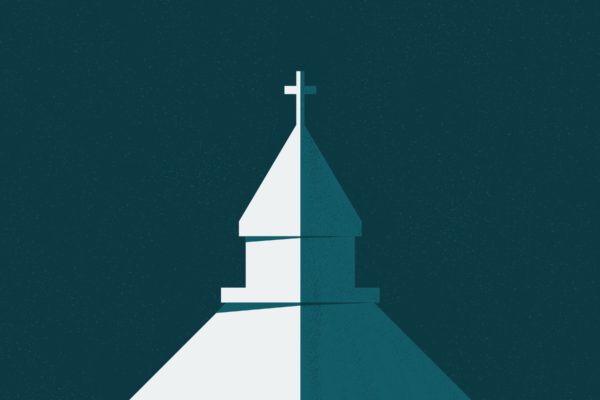We had a discussion this week in our office about whether or not unity is even possible in our denomination and in our country, and our conclusion was this: yes. A thousand times yes. Because, which separation, which distance is greater: that which, in our sin, divided us from Christ, or that which, in our sin, divides us from each other?
Romans 12 tells us not to be conformed to this world, and if you look into the text, it’s the first of many potter analogies used. The idea behind the word “conformed” is that of an artist using a model for his sculpture, conforming the clay to look like the model. We’re not supposed to look like the world. The world is not our model. We’re supposed to be an image of something, someone, not of this world.
Imagine a globe, like the ones in grade school history classes. It’s our best representation of what the world looks like. My globe growing up had dividing lines drawn all over it, denoting the various national boundaries, some of them remaining the same through centuries, and some of them changing even before you can draw them. I went to public school; our globe was old, and I remember my teacher making comments on countries which no longer existed or new boundaries which had been carved by war and conflict. If your globe was made in 2015, at this point in 2021 it doesn’t record about 27 global border shifts, most of them the results of war and treaties. The world, on a globe, looks like division.
Our nation looks like division. Some of our lines, like the racial lines, are centuries old, others of them are newer, like whether you think the presidential election was fair or stolen. Our nation looks a lot like the world.
I wonder what the SBC would look like on a map. My concern is that we in the SBC have used our nation as our model. Our dividing lines are the same: black or white, urban or rural, conservative or liberal, Southern or Northern, educated or not.
Now imagine a globe representing the Church universal. What do you see? When I try to imagine, I arrive at two possibilities, one of them I perceive from the world around me, the other I only see through faith.
The Church globe I see around me looks a lot like the globe of the world. There are dividing lines drawn all over it. The Catholics seem to have an ancient nation, roughly the size of China, with some other high-church denominations surrounding it. I imagine Pentecostalism as a nation that surprises me when I look at the globe, because it’s closer to me than I ever realized it was, even though they speak in a language I can’t understand (but I should probably learn a little bit, so we can be friendly). The SBC, as I’ve said, I imagine much like America; there’s a big urban/rural divide, huge wealth disparities, it’s composed of several states which will from time to time refuse to work as a whole, and the divides between more conservative and more liberal groups occasionally threaten to plunge it into civil war.
In one sense, the church today looks almost exactly as if it’s been fashioned after, sculpted, conformed to the pattern of, the world. We keep drawing lines in the sand and dirt, fighting, retreating, and returning again to the same conflicts under a different name.
But in faith, I’m able to see another globe for the Church. The one crafted by Christ in his high-priestly prayer, one conformed to the image of God: the church existing as separate persons, but a unified whole, acting in different roles but always toward the same end, of a single mind and unified purpose.
Which globe is more accurate? Which one is real? In faith, I believe Christ’s conception of his Church. When we try to draw the lines, the lines keep changing, we keep needing to revise. His conception of the church has been true and unchanging for millennia.
In faith, I see another map of the SBC, and I mourn. I’m tempted to despair. We’re so far from what we’re meant to be. But “when Satan leads me to despair, and tells me of the guilt within, upward I look and see him there, who made an end to all my sin.”
The truth is, Christ taught us long ago how to go about reconciliation, and he gave his life to accomplish it: it starts with confession. We need confession in our churches now more than we ever have. Confessing our sins to one another, admitting we are sinners in need of grace. Confession and repentance leads to forgiveness because of the death of Christ in our place. It’s his love which covers our multitude of sins and enables us to “keep loving one another earnestly.”
If you would mourn further division in our denomination, as you pray, as you teach and preach, as you have conversations: pray about, teach about, talk about your own sinfulness, your own part in division, even if your only part in division is an inability to effect change—the human limitedness endemic in sin—and ask the Lord for forgiveness and unity across our denomination and Church. Build confession into the life of your church, as a regular part of your services. Spend time, as a pastor or staff, writing prayers of confession each week. Make confession a core value, because it is core to our faith: to follow Christ, we first confess our sins.
The sinner’s prayer, so helpful with evangelism, is a prayer for all of the Christian’s life, not just the first moments. It leads us to confession: “Jesus, I am a sinner in need of your grace. Please save me from my sin, change me, and come be with me.” What if, a few years from now, the Southern Baptist Convention were known as a people who confess our sins, one to another, and are healed?
I saw a globe the other day without the national lines. It showed the ground, the mountains, the rivers and the seas, those things which God made according to his good will. Those are the boundaries he set by telling the waters “this far and no further,” and the waters obeyed, recognizing the voice of their maker and Lord. Imagine what the Church would look like if we could see it thus. I imagine a bride, resplendent and whole. We are already, and not yet.



